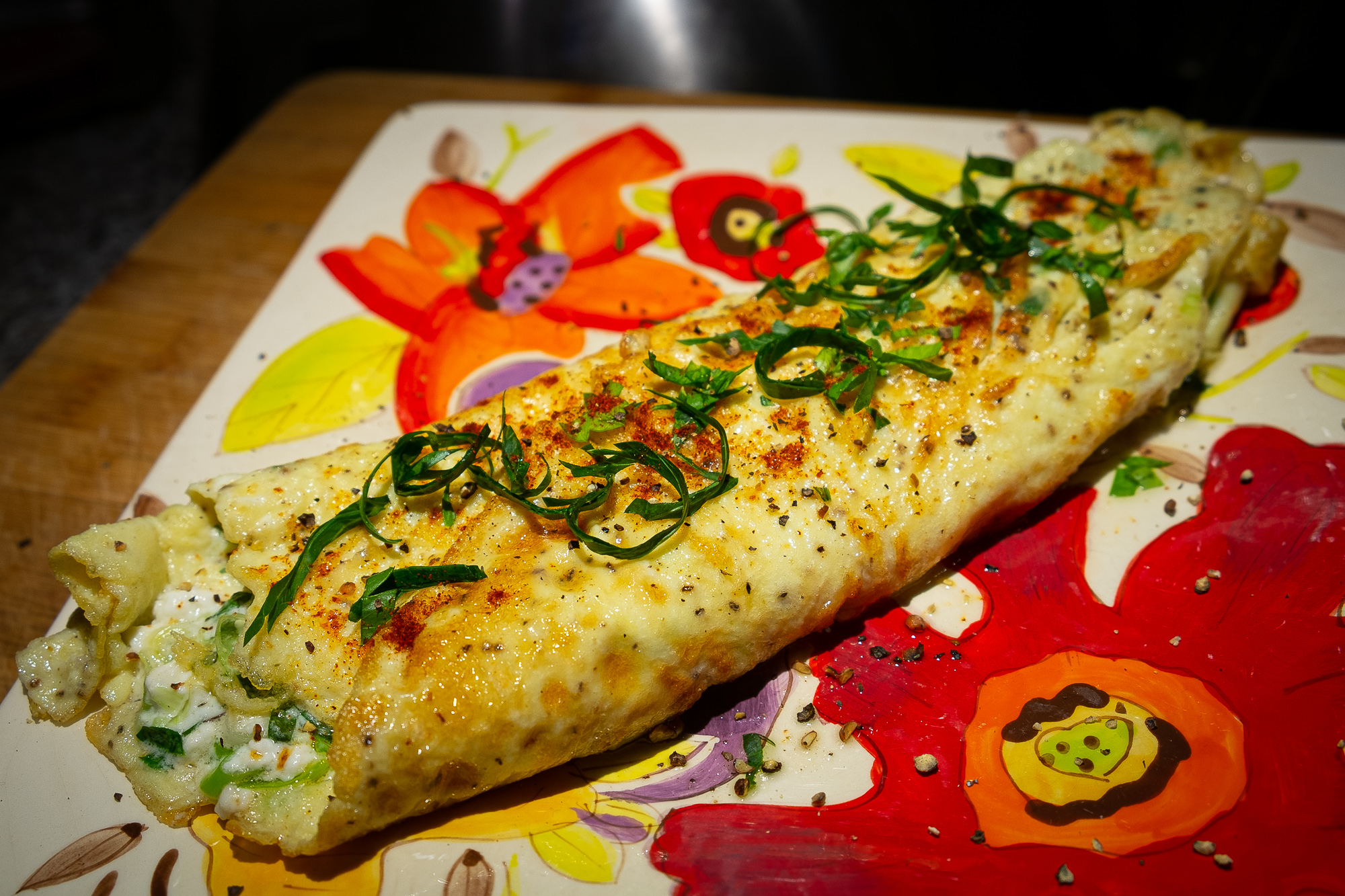It has been a while since we had a “folded” omelette isn’t it? Yep, we were craving one of those, so here it goes. This dish is something very easy to prepare, something working with whatever ingredients you have on hand and delicious to boot. No wonder is one of Casa Radu’s favorite brekkies/ brunches. The method I’m following is sort of Classic French but not exactly.

The ingredients, as I mentioned, are simple and not all that many especially if you think of them as generally divided into a few categories: omelet base, herbs and flavors plus “the filling” this last one being optional. The beauty of an omelet is that, apart from the basic components that are eggs, the variations you can bring into the mix are nearly endless. Any kind of combination, whether “by the book” or “whatever tickles your fancy” is entirely possible, the limit being only your own imagination. Another great aspect is the possibility of “filling” it not only with classic things like ham or cheese but also with God knows what else, from raw onions or smoked salmon to chili jam or chopped leftovers from the last potato stew still lingering in the fridge and begging to be used. To sum it up, the omelet is a simple way, or a pure sign of madness, or culinary genius (often the difference between is only one’s perspective), to create something absolutely personal for breakfast. Or lunch. Or dinner. Or when you feel like it. In the picture we have eggs, lovage, parsley, dried thyme, green onions, Greek feta and 35% cooking cream.

I’ve said it in the past, and I will most likely repeat it: the 35% cream is indispensable to all my egg mixtures, either omelettes, scrambled eggs or frittatas. The cream makes all these mixtures upon cooking nice and creamy and soft. Additionally the cream protects a little against overcooking the omelet… it’s like one of those storm anchors in this regard, doesn’t necessarily save you but gives you some maneuvering room before it is too late. So if you like a little more color on the outside of your omelet, the cream will help in keeping the inside softer. Any kind of larger percentage fat milk will also work, basically anything between 3% and 35%, the fatter the better in my experience. Here I mixed the eggs with salt, pepper, part of the herbs, chopped green onions and cream. It doesn’t hurt to beat the mix with a fork or even a whisk. We want to “aerate” it a bit.

To keep in true French tradition, some butter is melted in the skillet over medium heat. I’m also mixing, in the true… umm… Italian?… tradition, a little olive oil. This oil raises the “smoking” point of theun-clarified butter. I’m trying to avoid having “burnt butter” here. Some people like it, but I’m not a fan of this particular taste in omelets, however,I’m also far from limiting anyone’s freedom of expression here – it’s just a personal preference. Finally…. once the mixture is in the pan, the French classic method has the pan and the egg mixture shaken/ stirred simultaneously, periodically bringing what’s setting on the edge of the pan towards the center, in order to keep this center as wet and delicate as possible. The omelet is then “folded” by bringing it to the edge on one side and by turning it over directly on the plate on the other side. Bon Appetit, Chef Pepin would say at this point (you can search for his method on YouTube). I’m a little less “Chefy” so I’m just shaking the pan until the bottom sets and the omelet starts moving “together”, like a pancake. At this point, the top is only slightly set, soft and delicate. At this point you can roll it like a pancake and serve it hot if no filling was planned, or if the filling has been mixed in from the very beginning. I do like like a filling however, a little warm surprise inside the omelet!

Now’s the moment for quick action… not too much time for pictures. The the omelet’s bottom is now starting to brown and the omelet becomes progressively harder to fold. As you can see, the egg on top is only a little set, so the right time to add the filling is now. It is also ideal to “scan” for the proper well folding “halves” and “orient” the filling accordingly, thus making our folding task easier. As filling in this case, I have Greek feta mixed with herbs and green onions, passed loosely through the knife once. It is one of the simplest and tastiest fillings, especially if you have some nice quality feta. Like anything else in life, simple things are both easy to control and delicious.

As you can see above, a great, an easy-to-handle non-stick pan is an absolute must-have for making omelettes. With the pan tilted to one side and shaken a little, half the omelette folds almost by itself. Repeat the process for the other half. That’s pure magic Monsieur!

A very important point here: the serving plates MUST be warm. Without exception. A cold plate sucks the heat from the omelet immediately and the result becomes somewhat flat, a little cold and missing that “spark”. I usually heat the plates in the oven set on “warm”, a method also having the added advantage of keeping the omelettes warm when you have more than a couple to do and serve at the same time. Here I’ve finished it with some herbs, freshly ground pepper and a little sprinkle of smoked Spanish paprika. Sandra made some butter on toast. The perfect way to start the day! Anyone for an omelet? Step right up!
Recent Comments